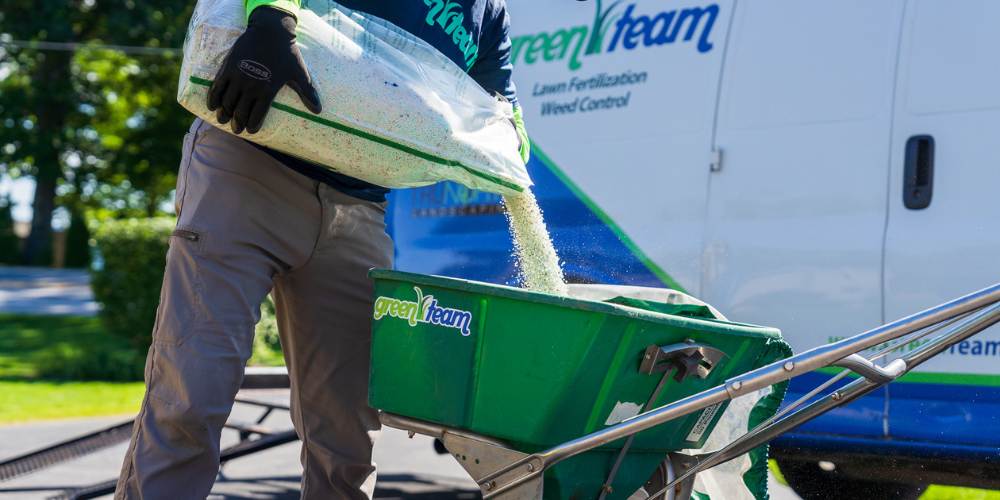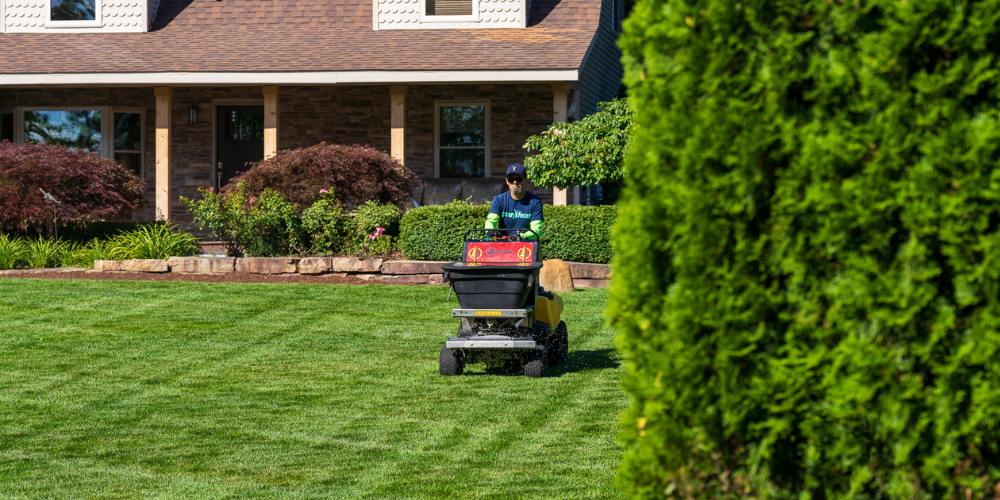
What is Lawn Fertilizer and Why Does it Work?
Have you ever watched your lawn care provider spread tiny fertilizer balls across your yard or spray your grass with a fine mist, and thought What exactly is in that stuff?
You know it works—your lawn starts to look greener, thicker, and healthier after just a few treatments—but have you ever wondered why? What is it about those little nutrients that make such a big difference? And why does your grass need it in the first place?
We get it—it can be a bit mysterious, especially when you just want a beautiful, vibrant lawn without having to become a gardening expert. But understanding why fertilizer works can actually help you appreciate the role it plays in keeping your lawn lush and thriving. In this blog, we’ll break it all down for you in a way that makes sense—because at the end of the day, a healthier lawn means less stress for you and more time to enjoy it!
What is Lawn Fertilizer?
At its core, fertilizer is a substance added to soil to provide essential nutrients that help plants grow. Just like how we need food for energy and health, plants rely on specific nutrients to thrive. Fertilizer works by replenishing the nutrients in the soil that plants use up as they grow. When your lawn isn’t getting enough of these vital nutrients from the soil naturally, fertilizer steps in to give it the boost it needs to stay green, lush, and strong.
Types of Fertilizers
There are two main types of fertilizers: synthetic (chemical) and organic. Both provide the essential nutrients plants need, but they do so in different ways.
- Synthetic (Chemical) Fertilizers: These fertilizers are manufactured in a lab and are precisely formulated to contain specific nutrient ratios. They’re designed to give plants a quick nutrient boost, often producing fast results. These fertilizers tend to be highly concentrated, meaning you can apply less for a significant impact. However, because they’re chemically produced, they don’t add any organic matter to the soil, and overuse can sometimes harm the environment.
- Organic Fertilizers: These are derived from natural sources, such as compost, manure, bone meal, and other plant and animal materials. Organic fertilizers not only provide nutrients but also improve the soil’s structure and microbial activity over time. While they work more slowly than synthetic fertilizers, they tend to be gentler on the environment and support long-term soil health.
Forms of Fertilizer
Fertilizer comes in several different forms, each with its own advantages depending on your lawn care needs:
- Solid Fertilizers: These are granular or pellet-like fertilizers that can be spread evenly over your lawn. They can be quick-release, providing nutrients to your grass immediately, or slow-release, feeding your lawn over a longer period.
- Liquid Fertilizers: These are applied as a liquid solution and can be absorbed quickly by plants. Liquid fertilizers are often used for foliar feeding, where the nutrients are sprayed directly onto the leaves, but they can also be applied to the soil. They’re perfect for quick fixes when your lawn shows signs of nutrient deficiencies.
- Slow-Release Fertilizers: These are often solid, but the key difference is that they release nutrients gradually over time. This helps maintain a consistent supply of nutrients without the risk of over-fertilization, making them ideal for long-term lawn health.
Each type of fertilizer has its place, depending on your lawn’s needs, the time of year, and your personal preferences. Whether you choose synthetic, organic, or a slow-release option, they all play an important role in keeping your lawn healthy and vibrant.

What is Actually in My Lawn Fertilizer?
Fertilizer works by providing essential nutrients that plants need to grow strong and healthy. These nutrients are categorized into primary, secondary, and micronutrients, each playing a specific role in your lawn’s development. Here’s a closer look at what’s inside your fertilizer and how these nutrients help your lawn thrive.
Primary Nutrients
- Nitrogen (N): Nitrogen is the key nutrient responsible for promoting lush, green growth. It helps plants produce chlorophyll, the green pigment that allows them to perform photosynthesis and turn sunlight into energy. For your lawn, nitrogen is crucial for creating that rich, vibrant color and encouraging new growth. When your grass looks particularly green after fertilization, it’s usually the nitrogen doing its job.
- Phosphorus (P): Phosphorus is essential for strong root development and overall plant vigor. It plays a critical role in energy transfer within the plant, helping it grow roots, flowers, and fruits. For your lawn, phosphorus helps establish deep, strong roots that allow the grass to better absorb water and nutrients from the soil, making it more resilient to drought and other stressors.
- Potassium (K): Potassium enhances disease resistance and overall plant health. It helps regulate the plant’s water balance, making it more resistant to heat and drought. Potassium also plays a role in the production of enzymes that help the grass resist pests and diseases. A healthy lawn with adequate potassium is better equipped to endure harsh weather conditions and fight off common lawn problems.
Secondary and Micronutrients
While nitrogen, phosphorus, and potassium are the primary nutrients, there are also secondary nutrients and trace elements that play essential roles in plant health, especially at different times throughout the year.
- Calcium: Calcium is important for cell wall structure and helps plants take up other nutrients more efficiently. It also promotes healthy root development and overall plant growth.
- Magnesium: Magnesium is a key component of chlorophyll, so it helps with photosynthesis, enabling plants to produce energy from sunlight. It also helps with enzyme activation and supports strong, healthy plant cells.
- Sulfur: Sulfur is crucial for the formation of proteins and enzymes within the plant. It also helps plants resist diseases and pests, and it plays a role in improving the plant’s overall vigor.
- Trace Elements: These include a variety of micronutrients like iron, zinc, boron, copper, and manganese, which are needed in small amounts but are still vital for plant function. Each trace element supports various functions such as enzyme activation, photosynthesis, and nutrient uptake.
Together, these nutrients work in harmony to support the growth, health, and vitality of your lawn. By understanding the role of each nutrient, you can better appreciate why your lawn needs the right balance of fertilizers to stay green and strong throughout the year.

How Does Fertilizer Help My Lawn?
Fertilizer plays a key role in boosting your lawn’s overall health, appearance, and resilience. By providing the right nutrients, it encourages your grass to grow stronger, greener, and more robust. Here’s a closer look at how fertilizer works to keep your lawn in top shape:
Grass Health and Appearance
Fertilizer is like a supercharger for your lawn’s appearance. The nutrients it provides—especially nitrogen—are essential for promoting vibrant, green grass. When your lawn gets the right balance of nutrients, it produces more chlorophyll, which gives grass its rich, green color. Regular fertilization helps ensure that your lawn looks lush and healthy, even during periods of stress or extreme weather. Fertilizer also promotes thicker turf, filling in bare spots and making your lawn look fuller, denser, and more uniform.
Root Strength
One of the most important ways fertilizer helps your lawn is by improving root development. Strong roots are the foundation of a healthy lawn, allowing your grass to access water and nutrients more efficiently. Fertilizer, especially phosphorus, supports root growth, helping them establish deep and resilient networks beneath the soil. This is particularly important for drought resistance—lawns with deep roots can survive longer without water, as they can tap into moisture deeper in the soil. Strong roots also make grass more adaptable to changes in weather, helping it recover faster from seasonal stress or heavy foot traffic.
Weed and Pest Resistance
A well-fed lawn is a healthy lawn, and healthy grass has a natural advantage when it comes to battling weeds and pests. When your lawn receives adequate nutrients, it grows more vigorously, which means it can outcompete weeds for sunlight, space, and nutrients. Fertilized grass also tends to be thicker and denser, making it harder for weeds to take root. Additionally, healthy grass is more resilient to pests and diseases. A robust lawn can better withstand insect infestations, fungi, and other common lawn issues, reducing the need for chemical treatments and keeping your lawn looking pristine without as much effort.
In short, fertilizer helps ensure your lawn has all the resources it needs to grow thick, strong, and beautiful, while also building its resilience against common lawn problems. The result is a healthier, more vibrant lawn that can withstand the challenges of weather, pests, and weeds.

When and How to Apply Fertilizer
The best times to fertilize your lawn are early spring, late summer, and fall. These are the periods when grass is actively growing and can effectively absorb nutrients, helping it thrive through the warmer months and recover for winter. Fertilizer can be applied using a spreader for granular forms or as a liquid application. Be sure to follow the recommended amount on the label to avoid uneven coverage. Over-fertilizing can lead to nutrient burn, harming your lawn and the environment. Stick to the recommended application rates to keep your lawn healthy and safe.
When and how to fertilize has been such a frequently asked question, that we’ve written several blogs to help answer any questions you may have:

Partnering with a Lawn Care Professional for Fertilization Services
Fertilizer plays a vital role in keeping your lawn healthy, green, and resilient. By providing essential nutrients, it encourages lush growth, strengthens roots, and helps your grass stand up to weeds and pests. Understanding how and when to apply fertilizer ensures your lawn gets the right care at the right time.
If you’re ready to take your lawn to the next level, Green Team is here to help. With years of expertise in lawn care and a commitment to sustainable practices, we can help your lawn thrive all year long.
Contact us today to schedule a consultation and let our experts take care of your lawn’s nutritional needs!

Stay in “the know”! Sign up for our free quarterly newsletter to learn tips & tricks for maintaining the perfect yard.
We take your personal information very seriously. We will not share any of the information you provide with any 3rd parties. Provided information will be used specifically to contact you in regards to your inquiry.
Get Started Today
– 1 –
Give us a call or get started by filling out our contact form
– 2 –
Talk with one of our professionals about a plan that works best for you
– 3 –
Sit back and relax. The Green Team will come out swinging



